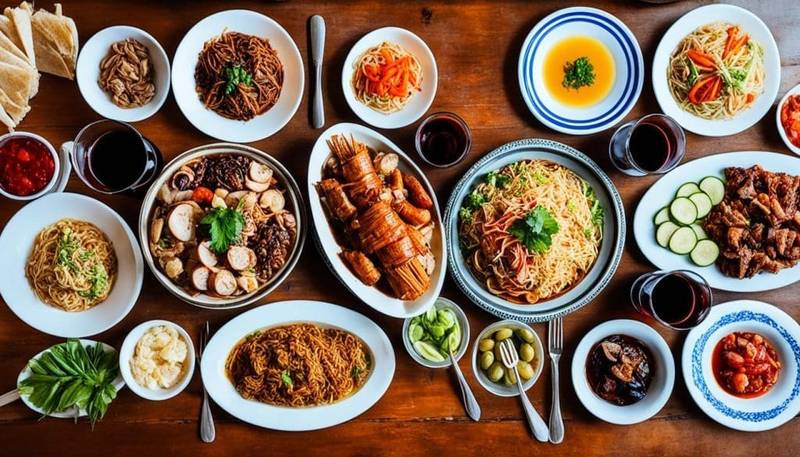When the complex medley of flavours in Filipino dishes meets the refined world of wine, a revelation in culinary harmony is born. But how do you navigate this lush landscape and master the art of wine pairing with Filipino food? The challenge and charm lie in the unique blend of sweet, sour, and savoury tones that characterise Filipino cuisine—a mosaic begging to be paired with the perfect vinous counterpart.
Embarking on the journey of Filipino cuisine wine pairing opens up a realm where each sip and bite are an interplay of complement and contrast. Whether we’re dining on the traditional savouriness of Adobo or indulging in the hearty richness of Afritada, the quest for the ideal wine companion is as thrilling as the flavours themselves. This exploration is not just about pairing wine with traditional Filipino meals; it’s a pursuit of cultural delight, a chance to enhance cherished recipes with a touch of elegance and discovery.
As we delve into this flavourful foray, each pairing suggestion is poised to elevate your meal to an exquisite gastronomic experience. Join us as we unveil the secrets to perfecting your table’s symphony, where Filipino cuisine and fine wines dance in delectable harmony.
The Art of Pairing Wine with Traditional Filipino Meals
Finding the best wine pairings for Filipino dishes requires an understanding of the rich tapestry of flavours within Filipino cuisine. The traditional Filipino feast is nothing short of a complexity that thrives alongside the right wine. Take, for instance, the vibrant sourness of a classic Sinigang—a stew that is both refreshing and robust. A Chardonnay, beaming with fruit-forward smiles, merges with the dish to highlight its tangy tamarind broth without overwhelming the palate.

Consider the hearty nuttiness of Kare-Kare, a Philippine stew that’s thickened with peanut sauce. Here, a Merlot steps in with its plush, velvety embrace, enriching the experience and magnifying the stew’s soulful harmony of meat and vegetables. The concept of pairing wine with Filipino food celebrates this symbiotic dance.
Think of the iconic Lechón, with skin so wonderfully crisp it sings, and flesh so lusciously fatty it demands to be balanced. This is where a Riesling—with just a whisper of sweetness—cuts clean through, offering a counter to the richness while complementing its intrinsic savour. Seafood dishes such as Kinilaw, thriving on sharp hits of citrus and vinegar, find accord with the zesty personality of a Sauvignon Blanc. This varietal, known among top wines for Filipino food, adds its own touch of brilliance without muting the dish’s bold declarations.
But indulge us further: picture a bowl of creamy Macaroni Salad, its sweetness a testament to Filipino culinary playfulness. A glass of effervescent Prosecco toys right back, the bubbles chiming in with each creamy forkful, reminding us that food and wine exist in a realm of joyous enterprise and discovery. Such expert wine pairings for Filipino cuisine not only enhance a meal but transform it into an elaborate feast for the senses.
Embrace the symphony of taste in a traditional Filipino meal paired perfectly with a handpicked bottle of wine—one that dances harmoniously with each dish’s unique character, creating a dining experience that resonates with warmth and communal joy.
Expert Wine Pairings for Filipino Cuisine
Finding the perfect wine to complement the rich and varied flavours of Filipino food can transform a meal into a culturally immersive experience. Whether serving a traditional adobo or the succulent sweetness of barbecue, the right wine pairing can enhance the depth and enjoyment of Filipino dishes. Below we explore harmonious pairings that especially highlight the culinary delights of the Philippines.
Creating Harmony: Adobo and Red Wines
Adobo, with its full-bodied flavour, demands a wine that can stand up to its boldness. The profound, peppery notes of Shiraz or the softer tannins of Grenache meld seamlessly with Adobo’s rich savoury sauce, providing a sip that compliments rather than competes. A Côtes du Rhône reflects Adobo’s salty, sour profile, conjuring a partnership that sets the taste buds alight.
Afritada and Medium-Bodied Reds: A Tangy Dance
The playful tang of Afritada stew calls for a wine with character — one that dances alongside rather than taking the lead. Medium-bodied reds such as Tempranillo enhance the dish’s tomato acidity whilst harmonising with its meaty undertones. A well-chosen Zinfandel, with a hint of spice, complements the balance perfectly, leaving a flavour that lingers delightfully on the palate.
Barbecue Flavours Enhanced with Zinfandel and Syrah
For the sweet glaze that typifies Filipino barbecue, Zinfandel offers a complex flavour profile that resonates with the marinade’s sweet, smoky charm. Those who favour fiery warmth will find that Syrah underscores the barbecue’s nuanced spices. It’s a robust pairing, crafted for those who appreciate depth in both their food and wine.

Wine Pairing with Filipino Food
Embarking on the journey of wine pairing with Filipino food transcends mere gastronomic indulgence — it represents a festive homage to a culinary tradition rich in both taste and culture. The practice of finding the right vino to accompany Filipino dishes is less a science and more an art; it invites connoisseurs and novices alike to discover how the perfect bottle of wine can elevate a meal from delightful to unforgettable.
Consider the traditional and indulgent Pata, a dish known for its mouthwateringly crispy skin. The bold flavours of this dish are beautifully cut by the lively effervescence of a Champagne or Cava, introducing a refreshing clarity to the palate. This pairing is a testament to the dynamic of filipino cuisine wine pairing, where the juxtaposition of textures and tastes brings forth an unparalleled dining experience.
Indulge in the gastronome’s delight with Sisig, a remarkable Filipino creation that speaks volumes through its fatty, crispy bites. When paired with a glass of Pinot Noir, the robust yet subtle flavours marry, crafting an ensemble that sings to the palate with a harmony as jubilant as Filipino festivities themselves.
There’s a vibrant simplicity in enjoying Kilawin, the Filipino ceviche, while sitting by the ocean. The fresh zing from the marinade finds its counterpart in a refreshing glass of Albariño, which effortlessly matches the dish’s liveliness, making every sip a dive into the country’s tropical essence and every bite a celebration of its seaside splendour. Indeed, the art of pairing wine with traditional Filipino meals is more than just a culinary practice; it’s an invitation to a feast that’s as spirited and colourful as the archipelago’s rich tapestry of food and drink.
Conclusion: Celebrate the Harmony of Wine and Filipino Cuisine
The quest for perfect wine matches for Filipino recipes invites enthusiasts to a dance of flavour and tradition. Filipino cuisine wine pairing is an exquisite form of art; it’s not simply a matter of selecting a bottle but indulging in a journey that brings together distinct culinary notes with the elegance of wine. True appreciation comes from understanding the unique elements of Filipino dishes and the ways in which various wines can elevate the dining experience to new heights.
Balancing Flavours: Tips for Perfect Wine Matches for Filipino Recipes
To achieve the optimal balance, one should consider the dominant flavours of the dish—be it the deep savoriness of meats, the comforting sweetness in sauces, or the bright spark of acidity in marinades. A heat from spices found in some Filipino specialties welcomes the relief offered by sweeter or fruitier vintages. In contrast, the crispness of a quality Sauvignon Blanc can provide a refreshing palate cleanser to the symphony of robust flavours. Thus, through experimentation and exploration, food lovers can discover personal favourites and honour their culinary heritage with every sip.
Vibrant Celebrations: Choosing the Top Wines for Filipino Food
Selecting the top wines for Filipino food is a joyful expression of community and festivity. Whether it’s a heartwarming stew or a light vegetable dish, there is a wine to suit every occasion and palate. From a bold Cabernet Sauvignon breathing life into a rich Mechado to a zesty Sauvignon Blanc cutting through the citrus-infused Kilawin, the right wine can transform a meal from fare to fiesta. Australians are encouraged to dive into these taste adventures, pairing the vibrancy of Filipino cuisine with the finesse of the finest vintages, each glass of wine finding its perfect match in a dish, celebrating every recipe’s cultural delight with gusto.
FAQ
Q: What type of wine pairs well with the savoury tanginess of Filipino Adobo?
A: A deep, peppery Shiraz or milder tannins of Grenache are excellent choices for complementing the rich flavour of Adobo without overpowering the dish.
Q: Can you recommend a wine pairing for a rich tomato-based dish like Afritada?
A: To match Afritada’s savoury tang, a medium-bodied red like Tempranillo or a spice-kissed Zinfandel would harmonize beautifully with the stew’s balance of acidity and depth.
Q: What wine should I pair with Filipino barbecue?
A: A jammy Zinfandel is ideal for enhancing the sweet glaze of Filipino barbecue. For a spicier marinade, a robust Syrah or Shiraz can provide a compelling backdrop to accentuate the flavours.
Q: What is the best wine to accompany the Filipino classic, Kare-Kare?
A: For the nutty and rich flavours of Kare-Kare, consider a versatile dry or off-dry Rosé or a supple and velvety Merlot to enrich the dining experience.
Q: Which wine goes well with the creamy spiciness of Filipino Chicken Curry?
A: A buttery Chardonnay or a vibrant, off-dry Riesling can both stand up to the robustness of Filipino Chicken Curry, complementing the creaminess and spices.
Q: Are there any white wine options that pair with Filipino dishes?
A: Indeed, a bright Sauvignon Blanc brings out the tang in Bistek or Kinilaw, while a refreshing Albariño can be a perfect match for seafood dishes.
Q: How about a wine pairing for the traditional Filipino soup, Sinigang?
A: Sinigang’s distinct sourness is matched well by a smiling Chardonnay, whose crispness can complement the soup’s bright flavours.
Q: What wine pairs well with the crispiness of Lechón?
A: The fatty richness of Lechón can be balanced with a fruity and lightly sweet Riesling, which cuts through the fat and complements the crispy skin.
Q: Is there a wine that can pair with the diverse tastes encountered in a Filipino feast?
A: A sparkling Prosecco is a delightful choice for a diverse Filipino feast, offering the versatility to match with both sweeter dishes like Macaroni Salad and more savoury options.
Q: What type of wine would enhance the deep-fried indulgence of Filipino Pata?
A: The decadence of deep-fried Pata is wonderfully countered with a fresh, bubbly Champagne or Cava, which cuts through the richness with its effervescence.
Q: Can a bold red wine like Cabernet Sauvignon be a good match for Filipino dishes?
A: Yes, the structured body of a Cabernet Sauvignon can provide a refreshing contrast to dishes such as Bistek, or offer comfort when matched with a heartier dish like Mechado.
Q: What wine enhances the flavours of a fatty and crispy dish like Sisig?
A: A glass of Pinot Noir, with its balanced profile and subtle earthiness, can complement the rich and crispy textures of Sisig without overwhelming the palate.
Q: Are there any tips for creating perfect wine matches for Filipino recipes?
A: The key is to respect the dish’s flavours and find a wine that balances and enhances the dining experience. Experimentation is encouraged to discover personal pairings that resonate with your palate and highlight the best aspects of Filipino cuisine.
Q: How can I celebrate Filipino food with the right wine pairing?
A: Choosing the perfect wine involves considering the harmony of flavours, occasion, and personal taste. It’s about enhancing the joyous interplay of food and wine, turning any meal into a festive celebration of cultural richness and flavour.
Sip smarter, subscribe now!
Subscribe for gourmet tips, event updates, travel ideas, and a free e-book on Food Pairings. Start your journey to culinary and travel excellence!















